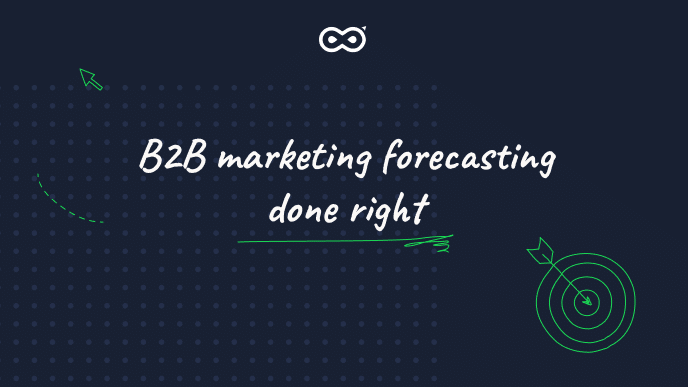“Marketing is all about guesswork that’s semi-educated at best”.
“There’s no way for us to run accurate forecasting on performance trends so let’s just do whatever everyone else is doing”.
“Hitting targets is a shot in the dark, and we never really know why we fail or nail them”.
Sounds vaguely familiar? Sadly, it’s not uncommon in our field to accept data limitations as a given. We’ve adopted a mindset of heavily relying on data for performance analysis, but when it comes to forecasting — we’re left to make educated guesses, cross our fingers and pray for the gods of B2B Marketing. Right?
Not necessarily. And certainly not anymore.
In the fast-paced playground we’re all part of, staying ahead of the curve means constantly questioning and optimizing our strategies. And one powerful tool that’s revolutionizing how marketers approach decision-making and minimize the “finger in the wind” component in their planning — is the ‘What-If’ analysis.
What does it mean exactly and why should it be a cornerstone in your marketing strategy? Read on to find out.
What is ‘What-If’ analysis anyway?
At its core, ‘What-If’ analysis is a method of exploring potential outcomes by slightly changing variables in your marketing strategy. It’s about asking questions like:
- What if we increase our budget for LinkedIn ads by $100,000?
- What if we cut our content syndication budget and reallocate it to Google Ads?
- What if we double our investment in events?
These questions might seem simple, but answering them accurately can be the difference between hitting your targets and completely missing the mark.
Why it matters
1 – Making informed decisions – Instead of relying on gut feelings or outdated playbooks, ‘What-If’ analysis allows you to make data-driven decisions based on tangible insights.
2 – Fortifying your competitive edge – Businesses that plan ahead recover from the impacts of market shifts faster compared to those that don’t. This agility can help marketers get ahead of issues faster, avoid unnecessary costs, and mitigate negative impacts better than the competition.
3 – Marketers are not data analysts – Drilling down into the data to be able to extract actionable conclusions usually calls for skill sets and knowledge that most marketers simply don’t have. ‘What-If’ analysis enables non-technical folks to access the answers they need with relative ease, without having to rely on back-logged data analysts.
4 – Optimizing budget allocation – By understanding the potential impact of budget changes, you can allocate resources more effectively, double down on channels and campaigns that perform well, or weed out those that perform poorly.
5 – Mitigating risk – Identifying potential pitfalls before falling into one allows you to adjust your strategy proactively and minimize loss.
6 – Fortifying stakeholder trust – Stakeholders don’t appreciate guesswork. Clear, quantifiable insights that are based on trusted data make it easier for marketers to justify their decisions to CEOs, CFOs, and other stakeholders.
The challenge
While the concept is straightforward, executing a robust ‘What-If’ analysis could be complex, which is why many B2B companies struggle to put them to use or even give up before getting started.
These are the key culprits marketers stir away from running ‘What-If’ calculations:
- They lack the data infrastructure to accurately measure the impact of all initiatives. And when you deal with skewed or fragmented data, you can’t really rely on anything the data tells you. Forecasting included.
- Traditional attribution models often fail to capture the full customer journey. This is because traditional BI and attribution solutions don’t help marketers fix their messy data, and instead just offer dashboards and reports that draw from fractured, duplicated, or untrustworthy data sources.
- The non-linear nature of marketing ROI makes simple extrapolations unreliable. You don’t know what you don’t know, which calls for a comprehensive predictive model that factors in cost, trend and attribution analysis.
How to conduct a ‘What-If’ analysis (the right way)
- Start with clear goals –
Define what success looks like for you for the following year: Is it growing pipeline by % amount? More qualified demo leads? MoM revenue growth by X amount?
Let’s say your main goal is around driving more Qualified Opportunities on a tight budget. To get an accurate assessment, we’ll make sure to take into account the relevant timeframe we’d like to measure, from the initial spend to the actual outcome.
- Map your KPIs –
Map the leading indicators you want to focus on and determine how they relate to the lagging indicators (typically used for goals).
Leading indicators are metrics that you can affect in the short-term using efforts that have a direct correlation to the lagging indicators you’re trying to impact.
So, identify the metrics that lead to your ultimate goal. Going back to our example, let’s map out our desired outcomes: If we’re looking to generate more Qualified Opportunities, we first need to ask ourselves — Can we have an immediate impact on the opportunity creation?
If the answer is no, the next question would be — What’s the most advanced metric that’s likely to have an immediate impact on our efforts, which would ideally show results within the same month of spend? This will give us a good signal on whether we’re on the right path to create these opportunities.
Let’s assume that typically, our efforts yield a certain number of leads, some of which are qualified leads that convert into Qualified Demo Requests (QDRs) within a 10 days window, and that 20% of our QDRs convert into opportunities within an average of 2 months.
So, we have QDRs as the leading indicator, Opportunities as the lagging indicator, a 20% conversion rate, and an average velocity of 2 months. This means we can now understand the conversion mechanism between these factors and our desired outcome, i.e. Opportunities.
- Forecast performance –
To forecast future results, use both run-rate calculations based on current performance (you can extrapolate results based on your actual result pattern to date) and budget forecasting as detailed below.
Going back to our QDRs example, now’s the time to run attribution analysis, as we’d like to ensure we’re not double-counting or abusing our calculations. We can calculate “cost per” investment type, where we can break down our efforts or investments in different ways.
In this example we’ll focus on a common breakdown, which is channels or campaigns. For each channel / campaign we invest in, what is the attributable cost per QDR based on our historical data?
When running budget forecasting analysis, we’ll base our calculations on the budget we’re planning to invest in each channel, the cost per QDR, the expected conversion rate between QDRs and opportunities, and how long it takes an average QDR to convert into an opportunity.
This will tell us how many QDRs we’re likely to generate each month, how many opportunities to expect as a result, and when.
- Identify potential gaps –
Based on our forecasting analysis, we need to ask ourselves — where we are falling short of your targets?
We’ll map and prioritize these gaps, as they’re our biggest potential risks and should be the main focus of our ‘What-If’ analysis.
Prioritization should be based on where our biggest gaps are, as well as metrics that matter most. We want to focus on specific KPIs as much as possible so we can then mitigate specific risks with ad-hoc decisions.
For example, let’s say that our forecasting analysis shows that we’re not likely to hit our opportunities target on time. To understand why that is, we might come to the realization that although we do manage to generate enough QDRs, our average velocity is too low, causing us to miss our goal’s time window.
To address this, we can focus our efforts on bringing QDRs from specific segments that have proven to offer a higher velocity.
Important note: Be sure to look at the previous couple of quarters to be able to factor in actual performance trends and accurate assumptions, and don’t be tempted to look just at the previous month or quarter, as the metrics might be misleading.
Good forecasting measures — e.g. forecasted cost per X, conversion rates, or velocity — are key for confident forecasting analysis.
Bear in mind that it usually takes more than two data points to be able to identify a clear trend and extrapolate the relevant metrics within your chosen forecasting time frame.
- Analyze drivers –
We’ll need to dig into the data to pinpoint the root cause for underperforming or outperforming KPIs.
Which segments and activities are driving or hindering success? Let’s single out channels, campaigns, and other segments that are either draining our budget or justifying our investment — so we could pivot our strategy accordingly.
- Model scenarios –
This is where the ‘What-If’ approach comes into play. Using forecasting analysis, we’ll model different budget allocations and their potential impact on our KPIs.
This type of analysis allows us to play around with different budgets per channel to assess their forecasted performance and make informed decisions accordingly.
- Iterate & optimize –
Over time, we’ll implement new insights to build additional scenarios, adjust our assumptions or variables, finetune our strategy, monitor performance, and then repeat the process.
A few important factors to consider
The following will help us get even more accurate predictions:
- S-Curves – Remember that ROI isn’t always linear, and that each channel or initiative may showcase diminishing returns after a certain point.
- Halo effects – Consider how changes in one area might impact others. For example, increased brand awareness might improve the performance of our direct response campaigns.
- Time lags – Some initiatives (like content marketing) tend to take longer to yield results. We’ll need to factor this into our analysis to paint a more realistic picture.
- Seasonality – Take into account both global seasonality, e.g. December is usually a low performance month. Also, factor in industry-specific seasonality, e.g. budgeting time frames in cases where our target audience is financial teams.
The not-so-distant future of ‘What-If’ analysis
As MarTech continues to evolve, ‘What-If’ analysis is becoming more sophisticated and accessible, allowing non-techy marketers to be less reliant on data analysts for reliable trend forecasting and sensible budgeting plans.
Next-gen attribution platforms that offer insights exploration are making it possible for you to:
- Automatically unify, clean, and model your data to ensure your analysis makes sense
- Uncover real-time insights, performance & operational recommendations
- Use AI and machine learning to improve forecasting accuracy over time
TLDR
- In today’s data-obsessed landscape, ‘What-If’ analysis isn’t just a nice-to-have — it’s a must-have for GTM teams that are looking to scale and move from reactive decision-making to proactive strategy optimization.
- The result of a well-executed ‘What-If’ analysis is more efficient spending, improved channels, campaign, and content performance, as well as a clearer path to achieving your marketing goals.
- Remember, the key is to start small, focus on your most important KPIs, and continuously refine your process. With practice and the right tools, you’ll be amazed at how effective your GTM decision-making becomes.



